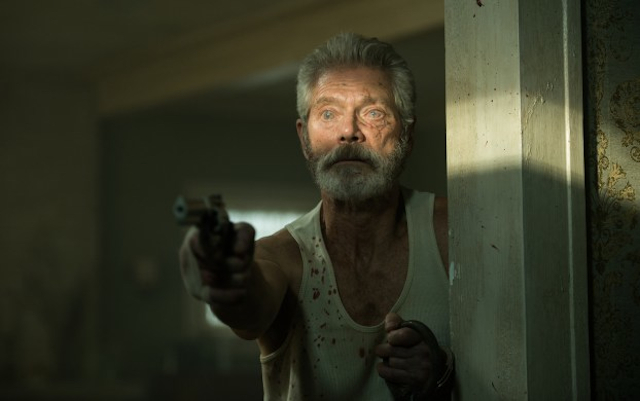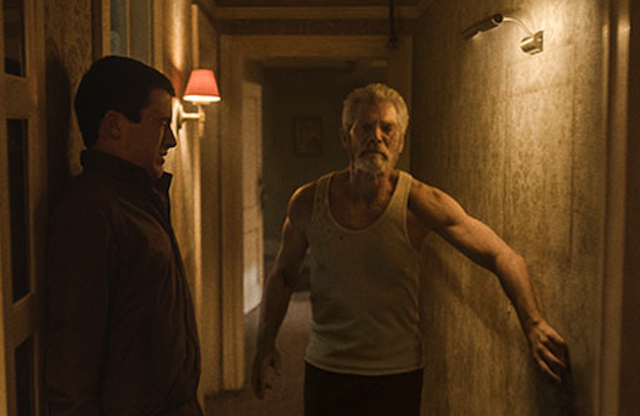CHICAGO – The Steppenwolf Theatre of Chicago continues to provide different viewpoints on the American stage, and their latest “Little Bear Ridge Road” is no exception. Featuring ensemble member Laurie Metcalf, it’s the resonate story of a family at the crossroads. For tickets/details, click LITTLE BEAR.
‘Don’t Breathe’ is a Terrifying Sensory Experience
 Rating: 4.5/5.0 |
CHICAGO – The horror genre can be a complex creature. The great films can show you the difference between ‘horror’ and ‘terror’. Some horror is all shock and no substance, while terror can be all fear, but no shock. The difference between them is so nuanced that only a skilled director, like Fede Alvarez, can show you the difference in his latest film, “Don’t Breathe.”
You don’t need a worldwide zombie apocalypse or some other pandemic plague to create an enveloping sense of dread. Sometimes all it takes is the confines of a room, house or even cabin. 90% of “Don’t Breathe” happens within the walls (sometimes literally) of a single house, but it uses this stifling sense of claustrophobia to its advantage. This isn’t writer and director Fede Alvarez’s first time confining his horror to a house, but it remains as effective as the first time. The set alone is meticulously curated with every detail becoming a part of the storytelling. Every dingy, paper-covered window, every layer of locks on the doors, and every ingrained shadows on the wall reveal a part of the story that is discovered while trying to survive. The set also plays a major role in character development and exposition, like having the brunt of The Blind Man’s (Stephen Lang) story told through news clipping and elements found in his own home.

The Blind Man (Stephen Lang) Defends His Realm in ‘Don’t Breathe’
Photo credit: Sony Pictures Releasing
Throughout the film, the title “Don’t Breathe” becomes less of the film’s core survival message and more of an audience-felt byproduct from the film’s suspenseful build-up. The complex technical design is complimented by the seemingly simple story and sparse dialogue. This strategy allows the film to explore other forms of storytelling and exposition, elevating it from the conventional doldrums that typically plague the genre. Instead, director Alvarez takes it one step forward and heightens the film’s sense of dread and terror with intrigue and spellbinding suspense to create a completely immersive horror/thriller hybrid.
Alvarez uses sight, sound, and sometimes their absence, to create the film’s tense environment. The cinematography is one of the most important narrative aspects of the film, using every scene as a statement or revelation about one of the characters or their situation. He uses light manipulation to create a sense of foreboding and obscurity to conjure feelings of fear. During a pitch black scene in the basement, Alvarez uses white phophur night vision to capture the true sense of darkness rather than continuing to use low light or natural-seeming lighting. This makes a great contrast in the film that helps distinguish between darkness and “blinding” darkness. It also introduces a layer of authenticity to the film since you can tell the actors couldn’t see a thing as they tried to traverse this maze of a basement.
“Don’t Breathe” puts you in the place of The Blind Man by making the film not just about everything you see, but everything you don’t see. Sound plays a significant role in creating the film’s atmosphere. The sound design makes sure that there are no static silences in the film, just like there aren’t any in real life. There is always a noise coming from some external source, like the low-humming of a light bulb, or the barely noticeable hiss of a radiator. In order to fill the void from the potentially vacuous silence, every low decibel noise that we hardly register in our daily lives is exaggerated to great effect in the film.
An impressive feat for the horror genre, “Don’t Breathe” creates complex characters that blur the lines between the conventional, binary definitions of “good” and “bad”. Outwardly, there appears to be no redeemable characters (except maybe the dog) as everything plays out in a mostly cause-and-effect manner. The greatest struggle the film faces is creating a character you can sympathize with even though you know that their motivations are self-serving and malicious. It succeeds not only once, but several times. Instead of doing this to one character, it switches part way through the film and does it to another character as soon as the film’s slightly obvious “twist” is introduced.

The Blind Man and Alex (Dylan Minnette) Illustrate the Title in ‘Don’t Breathe’
Photo credit: Sony Pictures Releasing
The complexity of the characters are able to shine, thanks to a great performance by Dylan Minnette and Jane Levy, who Alvarez worked with on “Evil Dead.” The greatest cast asset to the film is undeniably veteran stage and screen actor Stephen Lang. His character comes from a military background, which isn’t much of a surprise, but what is refreshing is that the military aspect is little more than background knowledge when compared to any other character he has played before. Lang’s preparation for the role is undeniable. Every mannerism and idiosyncrasy is refined to reflect his character’s current situation while remaining genuine and respectful to blind people as a whole.
This eye-for-an-eye revenge tale uses blindness not as a handicap, but as an advantage. It successfully plays on the blind swordsman trope, giving our “villain” heightened senses to compensate for the loss of his sight. Don’t let Alvarez’s use of tropes fool you because one of the best recurring themes is the subverting of the damsel in distress cliche by having Levy’s character aptly fighting back. We’ve seen this before in Alvarez’s previous film, “Evil Dead”, but it continues to be a refreshing change to having females being unfairly sexualized and then brutalized in the genre. At no point does this feel like the hypersexualized torture porn we often get from horror films starring female characters.
If you’re expecting “Don’t Breathe” to be another by-the-numbers horror film with unambitious aspirations, all I can say to you is: “Don’t hold your breathe.” Fede Alvarez weaves an insidious, sensory experience that will grab you by the jugular and refuse to let you go.
 | By JON ESPINO |


